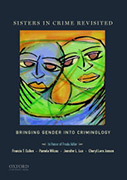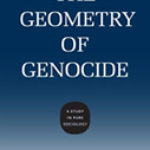Sisters in Crime Revisited: Bringing Gender Into Criminology

Editors: Francis T. Cullen, Pamela Wilcox, Jennifer L. Lux and Cheryl Lero Jonson
Publisher: New York; Oxford, UK: Oxford University Press, 2014. 432p.
Reviewer: Rosemary Barberet | September 2015
Sisters in Crime Revisited: Bringing Gender into Criminology is an edited collection of chapters devoted to revisiting Freda Adler´s 1975 criminological classic, Sisters in Crime: The Rise of the New Female Criminal. In the spirit of a festschrift, its aim is to honor and celebrate Freda Adler and her contribution to the field of gender and crime. In reviewing Sisters in Crime Revisited, I also took the opportunity to reread Adler´s original book. Cullen et al.’s book holds ambiguous aims, as expressed in the editors’ introduction: despite entitling the book Sisters in Crime Revisited, they state that contributors were not “recruited to celebrate Freda by commenting on a specific aspect” of her book but that rather, “this is a project inspired by our respect and love of Freda the person – not just a celebration of Freda the scholar” (p. 12). One is left wondering whether this work is to be reviewed like any other book on gender in criminology, or as a revisiting of Adler´s work and her persona. My review aims to be all encompassing.
Adler´s original book, researched with assistance from her first husband, Herbert M. Adler, contained nine chapters. Their intriguing titles are: Changing Patterns; Female Passivity: Genetic Fact or Cultural Myth?; The Oldest and Newest Profession; Minor Girls and Major Crimes; Women in Wonderland: The Psychotropic Connection; The Link Between Opportunity and Offense: Race; The Link Between Opportunity and Offense: Class; New Crimes and Old Corrections; Ladies and the Law; and an epilogue entitled, Liberation and Beyond.
A major strength of Adler’s groundbreaking work is the introduction of critical issues that had, heretofore, been largely omitted from mainstream criminology. Adler delivers beautiful prose in what is an exceptionally erudite work. She writes in the renaissance style of the men of her day, using each chapter to tackle a question aggressively, looking back in history as well as beyond the cultural confines of the United States to introduce and analyze a variety of topics related to women and crime. Her data include original interviews with offenders as well as law enforcement, literature, official statistics and secondary sources. Her book is eminently sociological, taking an intersectional look at crime, including gender, race and class, before the concept of intersectionality had even been coined. Aligned with liberal feminism, Adler sees women and men as essentially the same. The women’s movement, said Adler, was providing both legitimate and illegitimate opportunities to women which at some point would close the gender gap in offending. There is no reason to believe, she said, that women are ultimately more moral than men.
A close read of Adler´s book reveals that it is not only about women and crime, but also about a woman scholar finding her voice amongst a scholarly community that at the time was composed only of men who researched only men. This was Adler’s first major contribution to criminology after graduate school, which she returned to after 9 years of homemaking and raising children. It took her three years to write. The book was a huge hit, generating a great deal of media attention. Daringly, Adler tried to predict the future using the limited data available at the time, and her work resonated with the changing times in which she wrote it. There are not too many criminologists who have ever taken this kind of intellectual leap from a cliff.
Even though Sisters in Crime is recognized as a seminal work in criminology, there are aspects of the book that have not stood up to the test of time. As more feminist criminologists have entered the discipline, they have offered informed critiques that challenge some of Adler’s interpretations on women and crime. We have not reached gender equality, and the gender gap in crime has not been eliminated: even the five most high ranking countries on the United Nations Gender Equality Index (Norway, Australia, Switzerland, The Netherlands, and the United States) still have less than a quarter of their arrestees being women. Nor was the rise in the numbers of women in the 1970s as great in absolute numbers as to cause consternation; actually in many aspects related to crime, men and women´s etiology is different. But of course, hindsight is frequently 20/20. One prediction of Adler´s does resonate: “… as women gain greater equality with men, the male-dominated judicial process will likely treat them with less deference and impose more stringent sanctions” (p. 252). With the test of time, the field of criminology has many classics, from which some arguments have proven to be off target, but which nevertheless made a strong imprint on the field. In the spirit of gender equality, Adler´s book deserves a similar place in our classics since her controversial questions spurred criminologists to research gender – specifically women – and crime.
Sisters in Crime Revisited seeks to acknowledge this basic contribution. It includes eighteen well written and researched chapters by a combination of 38 senior and junior scholars. These chapters are grouped into seven parts: Celebrating Freda Adler; The Development of Offending; The Social Context of Female Crime; The Social Context of Female Victimization; Key Theoretical Issues; Patriarchy, Masculinity and Crime; and Women, Justice and Corrections. The celebration of Adler in these chapters is indirect. Five of the eighteen chapters fail to cite Adler´s work, and only four of them (Merlo & Pollock; Dodge; Schwartz & Steffensmeier; Stohr, Jonson and Lux) seem to fully engage with it. The breadth of coverage is wide, but it cannot be considered a rival to such more thorough handbooks on women and crime as Renzetti, Miller and Gover´s (Eds.) 2013 Routledge International Handbook of Crime and Gender Studies.
Merlo and Pollock provide a particularly well researched and reasoned chapter, clarifying that Adler was one of a number of early women criminologists who argued for the need to make women visible in our research. Dodge´s chapter foregrounds Adler´s work and argues convincingly for its relevance as concerns women and white collar crime. Hers is the chapter that engages the most with Adler´s work and finds relevance in it for current day research in this area. Messerschmidt and Tomsen provide an excellent update on the research on masculinities and crime, persuading us that Adler´s conceptualization of masculine women opened the field to researching femininities and masculinities that are independent of biological sex.
Some other chapters seem out of place, particularly the chapter on a biosocial perspective of female offending by Vaske, Boisvert and Wright. Their chapter does not cite Adler´s work, and in fact argues precisely against her sociological perspective, claiming that biological and psychological risk factors are being ignored in an explanation of women´s offending. Freda Adler will need to revisit this revisit! Overall, Sisters in Crime Revisited is well intentioned – as expressed by its enthusiastic editors – but it is a dry read compared to Adler´s original work, and fails to tackle some of the more interesting areas that fascinated Adler, such as sex work, race, class, and drugs. It is also almost entirely parochial, focusing on the United States, although Adler´s work has always had an international dimension.
The elephant in the room in Sisters in Crime Revisited is feminism — and it is an exceedingly interesting elephant. Only one chapter, “Does Feminist Theory Matter?” by Petersen, Salisbury and Sundt, deals with feminism in detail, but does not venture to explore the feminism inherent in Sisters in Crime. Five of the eighteen chapters, including the editor´s introduction, do not use the “F” word at all. Adler herself in various published interviews is loath to self-identify as a feminist. Yet her text actually betrays her:
It is not a man’s penis that a woman strives for but his power, and until recently the only way to achieve that has been through apparently paradoxical indirection (p. 9).
The distinctions of which we are understandably proud between the rule of men and the rule of law in fact disappear when we reflect that it is the men who rule that make the laws (p. 154).
Unfortunately, the mechanisms which have evolved for handling the crime of rape are nearly as cruel to women victims as the crime itself. Essentially, those mechanisms are a direct reflection of the traditional male bias and dominance evidenced throughout the criminal justice system (p. 214).
The question of whether women offenders are something feminists should be proud of or ashamed of is still a pertinent and interesting question, as well as whether crime commission is liberating in any way. Furthermore, Adler´s lesser known critique in Sisters in Crime of the gendered nature of laws and the patriarchal response of the criminal justice system to women as offenders and victims raises questions that are still unresolved, and that are the mainstay of much work in feminist criminology.
I was fourteen when Adler wrote Sisters in Crime, but I do remember that era of awakening: of watching my mother intrepidly go back to work after years of homemaking, and discover herself – perhaps similar to Freda Adler; of blaring Helen Reddy´s “I am woman, hear me roar” on the stereo, just as Adler does to introduce her first chapter. If we read her book in historical context and understand it as the dawning of a modern day woman scholar and criminologist, we have ever so much to learn from it, and about the wonderful criminologist and person that is Freda Adler. Sisters in Crime Revisited is a worthy celebration of Adler, but in my judgment falls short of its goals; nevertheless, it is to be lauded for its good intentions and solid scholarship.
Rosemary Barberet, Professor, Sociology Department, John Jay College of Criminal Justice, City University of New York


